44 Best High-Fiber Foods for a Healthy Diet
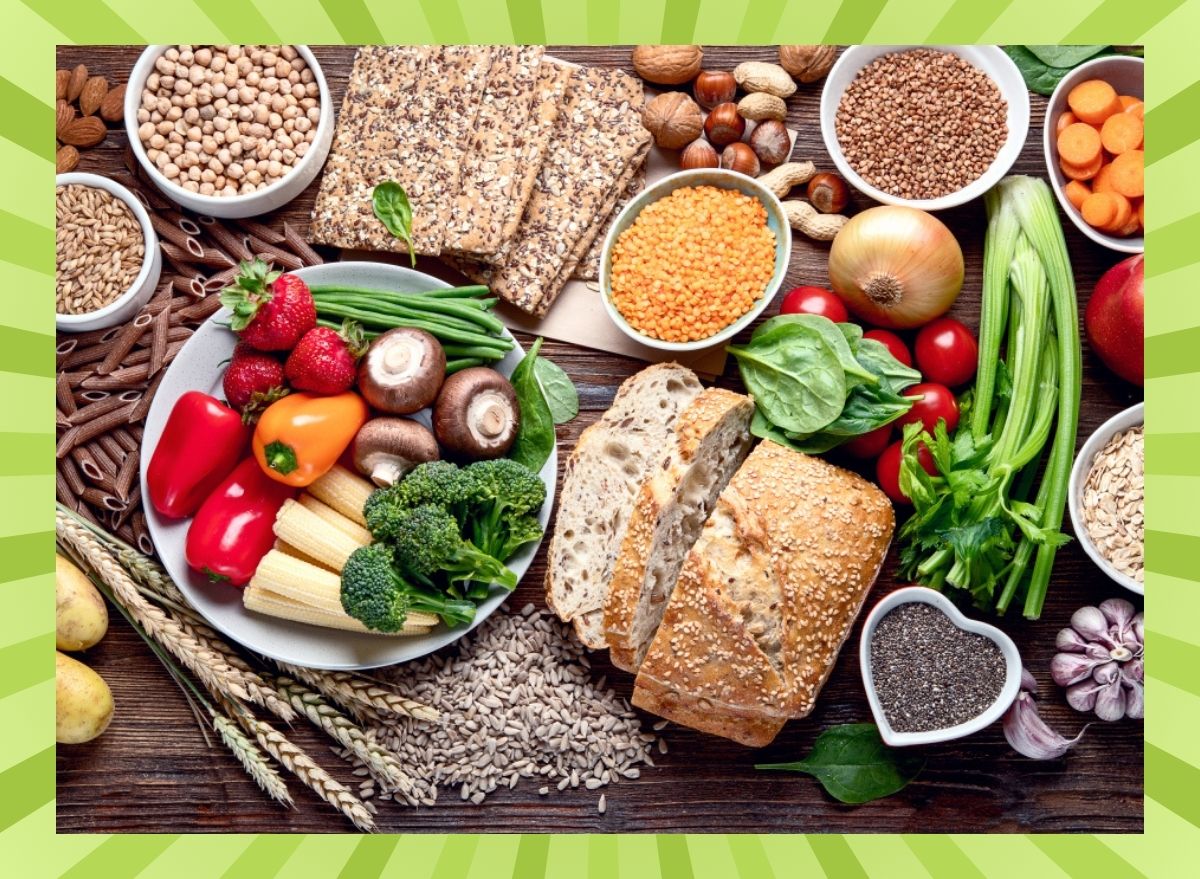
These healthy high-fiber foods help you feel full, support your digestive system, and make achieving your weight loss goals a lot easier.
Due to the highly refined, modern American diet, the average American isn't getting enough of one of the most important nutrients: fiber. Without a consistent intake of healthy, soluble, and insoluble high-fiber foods in your diet, you'll experience dips in energy, have difficulty losing weight, and also increase your risk of diabetes and other metabolic issues.
What is fiber?
Dietary fiber is a class of complex carbohydrates described as an indigestible long chain of sugar molecules. Fiber is naturally found in complex carb foods such as fruits, veggies, grains, and legumes.
This class of carbohydrates can be further broken down into two different forms: soluble and insoluble.
- Soluble Fiber: Soluble fiber dissolves in water. When it does, it combines with water to form a gel-like substance that creates bulk. This gel-like fiber helps to slow digestion, keeping you fuller longer and helping to balance blood sugar. Soluble fiber is also the type of fiber most closely associated with helping to lower cholesterol levels. Chia seeds, for example, are particularly rich in soluble fiber.
- Insoluble Fiber: Rather than dissolve in water, insoluble fiber moves through your digestive tract undigested. This bulking feature of insoluble fiber helps to move food through your body, adding bulk to stool.
Health benefits of eating high-fiber foods
Many different studies have highlighted how eating a diet high in fiber can boost your immune system and overall health, and improve how you look and feel. Some of the benefits of a high-fiber diet include:
- Digestive health. The most commonly cited benefit of fiber is its ability to support healthy bowel movements. Dietary fiber bulks up a stool to help move waste through your body. Eating a diet rich in high-fiber foods can help prevent constipation, reduce your risk for diverticulitis (inflammation of the intestine), and provide some relief for irritable bowel syndrome (IBS).
- Diabetes. An American Journal of Clinical Nutrition study found that fiber acts as natural protective armor against C-reactive protein (CRP), a sign of acute inflammation. When CRP is circulating in the blood, you are more likely to develop diabetes or cardiovascular disease down the road.
- Heart Health. "By improving cholesterol levels and decreasing inflammation, fiber can help to reduce heart disease risk and decrease blood pressure levels," says Tanya Zuckerbrot MS, RD, an NYC-based registered dietitian, who is also the founder of the F-Factor diet and a bestselling author.
- Body Weight. Fiber's bulking properties can help you feel fuller, which promotes weight loss by creating a caloric deficit without hunger.
How much fiber do you need to eat per day?
Americans should consume 28 grams of fiber per day if they're following a 2,000-calorie diet, according to the Food and Drug Administration (FDA).
Unfortunately, we're getting nowhere close to that amount. A report from the FDA says that the average American woman eats only 15 grams of fiber a day, while the average adult man consumes just under 19 grams per day.
Luckily, following a few smart swaps and intelligent additions of high-fiber foods to your diet can help you reach these suggested intake goals. Read on to learn about the best high-fiber foods, and for more healthy eating tips, check out 11 High-Fiber Lunches That Keep You Full.
The 16 best "excellent" sources of fiber
The following foods are considered to be an "Excellent Source" of fiber, which means they provide more than 20% of your daily value (DV). That translates to more than 5.6 grams of fiber per standard portion size.
Navy Beans
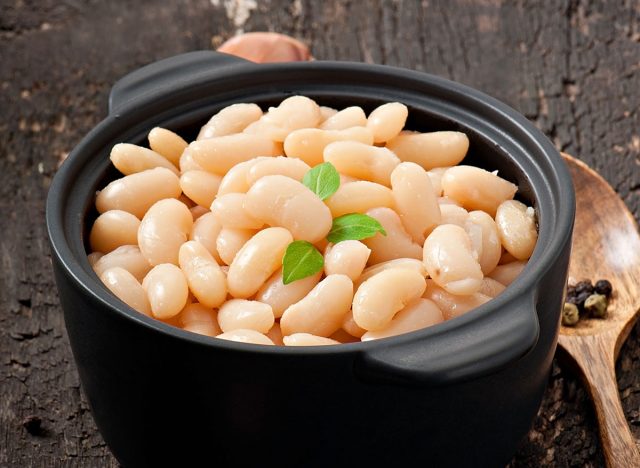
Fiber per ½ cup (cooked): 9.55 grams (34% DV)
Navy beans are by far one of the best sources of fiber, making them the most popular of all high-fiber foods. And even if you're not looking to get a whopping 34 percent of your daily recommended fiber intake in one serving.
Acorn Squash
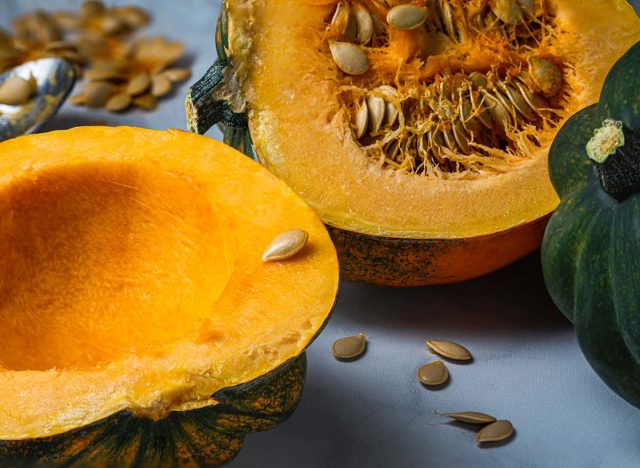
Fiber per 1 cup (cubed, baked): 9.02 grams (32% DV)
This wintery squash not only features a subtle, sweet taste, but one cup mashed provides your body with 6.37 grams of satiating fiber. Plus, acorn squash is also an excellent source of vitamin C—one serving provides about 20 percent of your daily needs—which is important for your immunity.
Black Beans
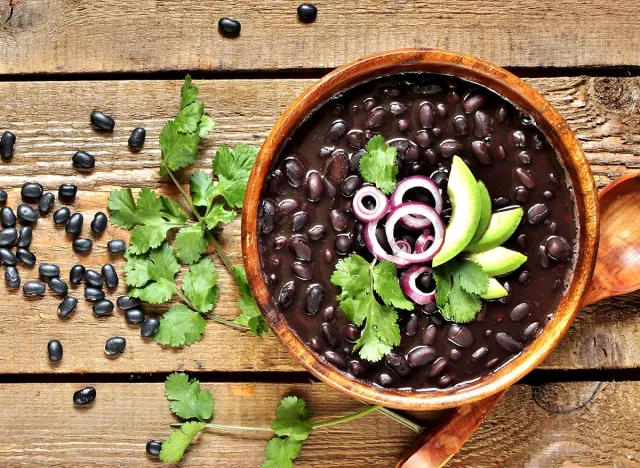
Fiber per ½ cup (cooked): 8.3 grams (30% DV)
Yes, the grammar school rhyme is right—beans are great for your heart, thanks to their 15 grams of fiber per cup, which work to lower bad cholesterol and fight against heart disease. "Beans are a great source of nutrition—they're high in protein and fiber, so don't forget about them! Add them to your salad at lunch or add them to a dish at dinner," says Jessica Crandall, RD, CDE, a Denver-based RD, Certified Diabetes Educator, and former National Spokesperson for the Academy of Nutrition and Dietetics.
Split Peas
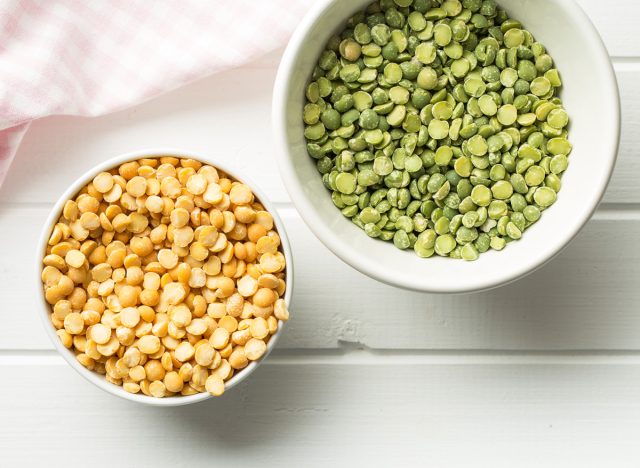
Fiber per ½ cup (cooked): 8.15 grams (29% DV)
Yep, they're different than green peas even when they look the same! With over 16 grams of fiber in one cup, a serving of split peas will get you to that recommended 10-gram meal mark and then some. You can stick with the age-old classic split pea soup, or use this as an opportunity to look up some fun new recipes for this high-fiber food and experiment in the kitchen.
Raspberries
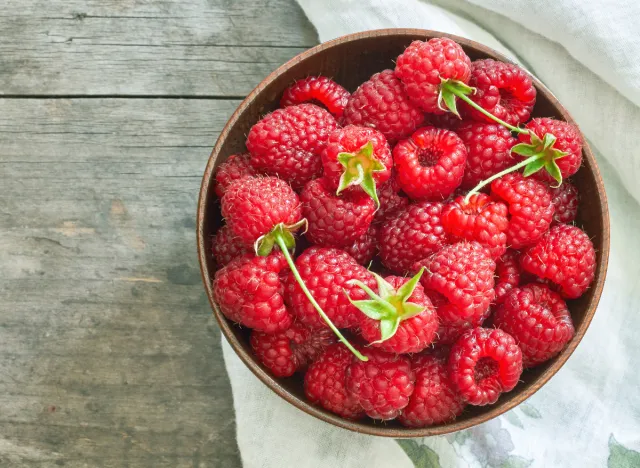
Fiber per 1 cup: 8 grams (29% DV)
Fruit, in general, is a great source of this macronutrient. And with 8 grams in one cup, raspberries steal the sweet spotlight. Mixing this antioxidant-rich berry in with your morning oats or cereal will fill you up, carry you through your morning, and push you to hit that daily 30 grams in no time.
Lentils
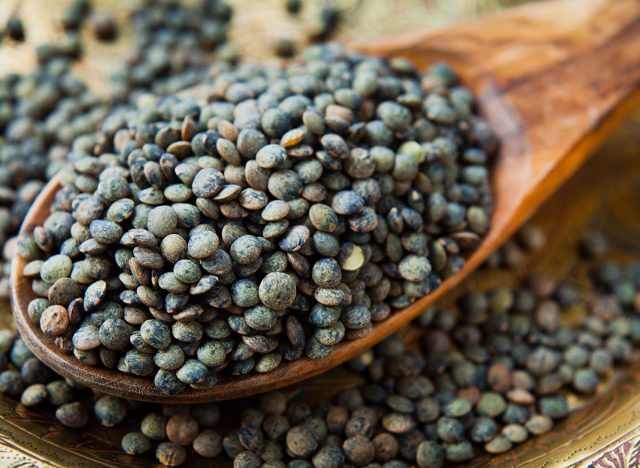
Fiber per ½ cup (cooked): 7.8 grams (28% DV)
Beans and legumes will always be standouts in this category. If you opt for a full cup of lentil soup, you could consume upwards of 16 grams of fiber, which can help keep your energy steady throughout the day. "Fiber helps to keep our blood sugars more stable so that we're not feeling highs and lows in our energy levels," says Crandall.
Another added benefit, according to Mary Sabat MS, RDN, LD, is that lentils "are also rich in protein, making them a great choice for a vegetarian or vegan diet."
Collard Greens
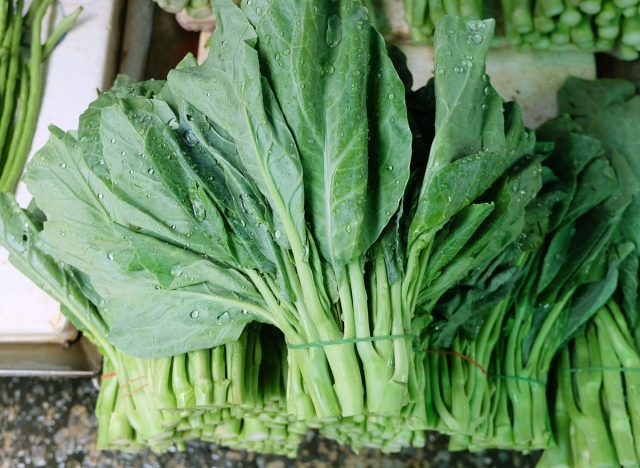
Fiber per 1 cup (cooked, chopped): 7.6 grams (27% DV)
Would you guess that a classic Southern comfort food could help you trim down? Collard greens are a great source of waist-whittling fiber. (And also tastes great with some crumbled bacon).
Blackberries
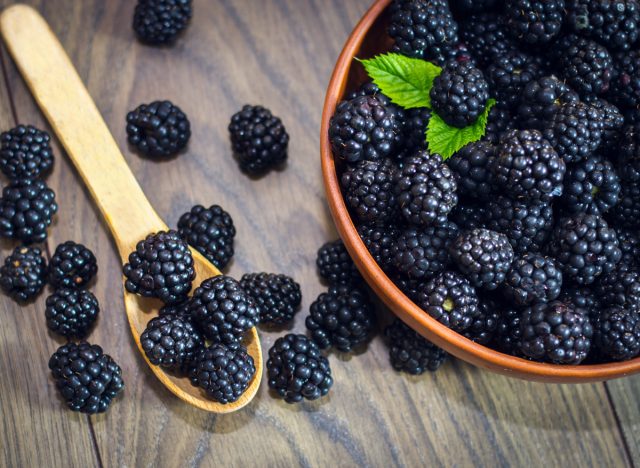
Fiber per 1 cup: 7.63 grams (27% DV)
Blackberries are a high-fiber food that contains 8 grams of fiber per cup, towering over strawberries and blueberries (which contain less than half that amount). Make sure to keep these dark-hued berries where you can see them; you'll be more likely to reach for them when sweet cravings kick in. "I store all my fruits and vegetables at eye level to make sure that I'm consuming them regularly," says Crandall.
Berries are rich in fiber but according to Lisa Young, PhD, RDN, "They are also high in antioxidants, which can help protect the body from inflammation and cell damage."
Green Peas
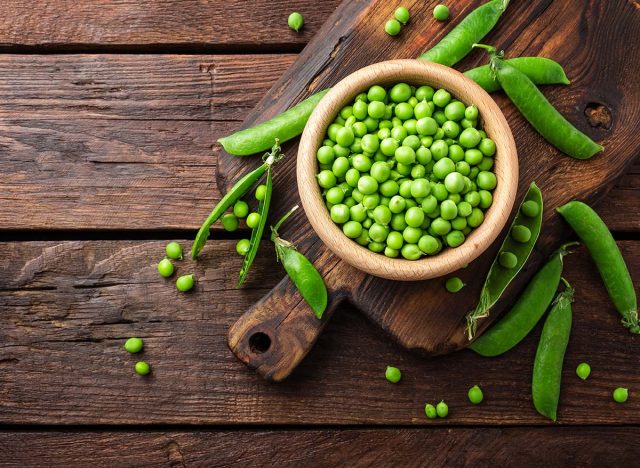
Fiber per 1 cup (cooked): 7.2 grams (26% DV)
You may have pushed them around your plate as a kid—but that stops now. These little green poppers contain a hefty 7 grams of fiber per cup! That same cup also boasts a hefty 8 grams of protein. "I highly suggest trying to micromanage your meals so that you get 7-10 grams of fiber at each meal," says Crandall. 7 grams? Easy, pea-sy.
Butternut Squash
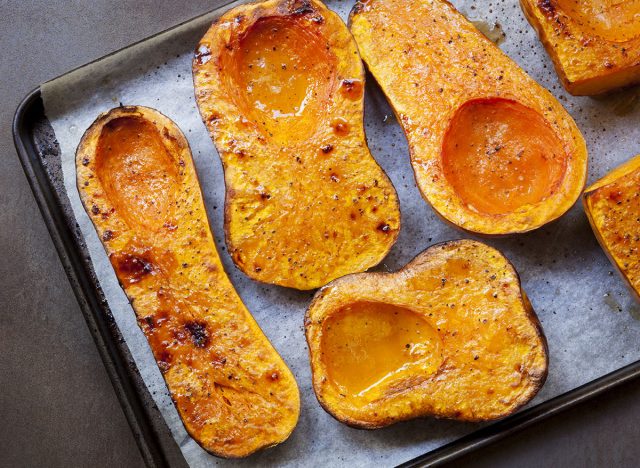
Fiber per 1 cup (baked, cubed): 6.56 grams (23% DV)
This winter squash is packed with fiber, which is not only good for your digestive system but also your cholesterol. According to a study published by The American Journal of Clinical Nutrition, a high-fiber diet has been shown to lower LDL cholesterol (also known as "bad" cholesterol) levels in the body.
Kidney Beans
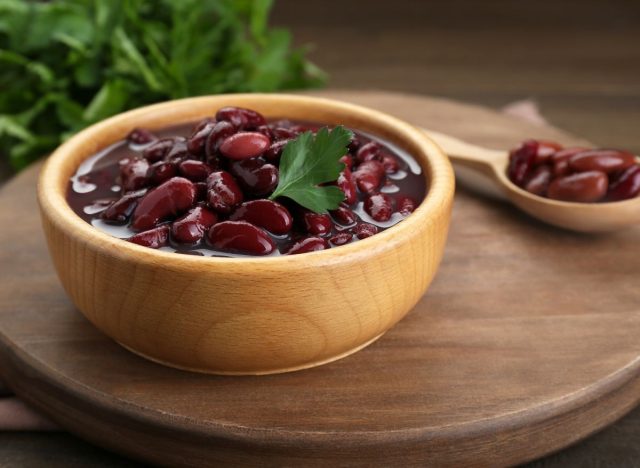
Fiber per ½ cup (cooked): 6.55 grams (23% DV)
Like most beans, kidney beans are very high in fiber content. These beans have almost 7 grams of fiber per serving, as well as 7.65 grams of protein.
Chickpeas
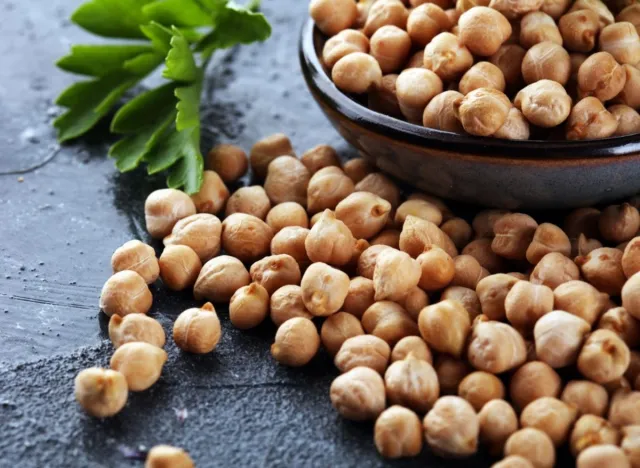
Fiber per ½ cup (cooked): 6.25 grams (22% DV)
One half-cup serving of chickpeas (also known as garbanzo beans) contains over 6 grams of fiber. So, pouring some over your salad will help you hit your daily requirements with minimal effort. Just be sure to keep portions small so that you don't overload on calories, especially when they are not the main event of your meal; a ¼ cup serving contains close to 200 calories in total. Use these chickpea recipes for more ways to get your fiber from these healthy beans.
Young adds that along with providing fiber, chickpeas "contain several nutrients such as folate, iron, and manganese."
Chia Seeds
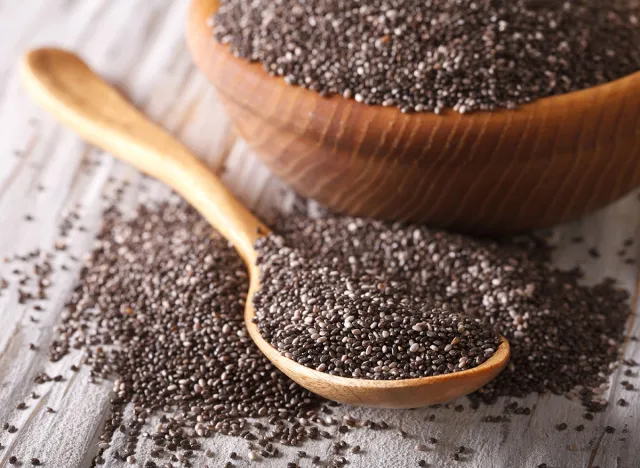
Fiber per 2 Tbsp (28.35 g): 5.73 grams (20% DV)
Anything with greater than 5 grams of fiber per serving is considered high. One ounce, or 28 grams, of chia seeds, has double that amount! Sprinkle a spoonful of these nutrient-rich seeds into smoothies, yogurt, or on top of salads to boost your fiber intake and reap the digestive benefits. We've also curated the best chia seed recipes for even more ideas!
Pomegranate Seeds
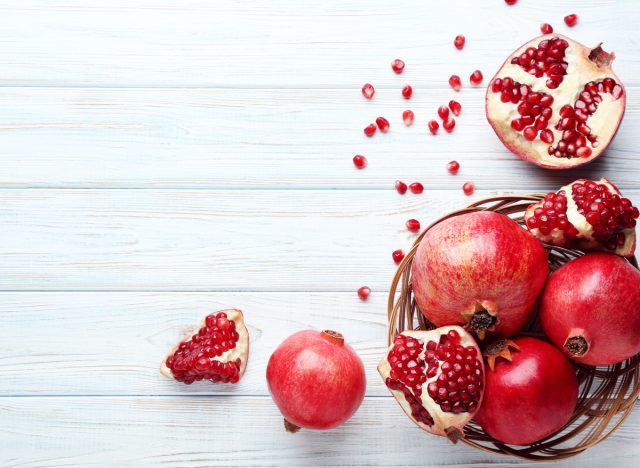
Fiber per seeds in ½ pomegranate: 5.65 grams (20% DV)
Pomegranate is another superfood that's packed with fiber. On top of this gut-friendly nutrient, pomegranate seeds are also teeming with polyphenols, a class of antioxidants that have been shown to shrink fat cells!
Flax Seeds
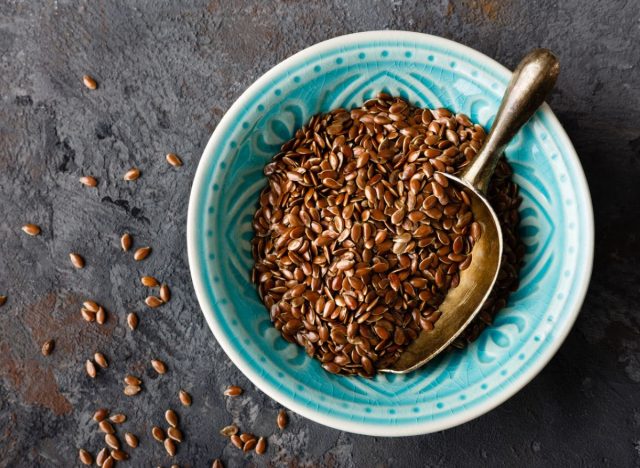
Fiber per 2 Tbsp: 5.62 grams (20% DV)
Although they're not quite at chia seed status, whole flaxseeds offer up to 7 grams of fiber per two tablespoons—which is more than those two bites of broccoli can claim. Use them just as you would chia seeds by sprinkling them over salads or mixing them into yogurt for a super-satiating snack.
Parsnips
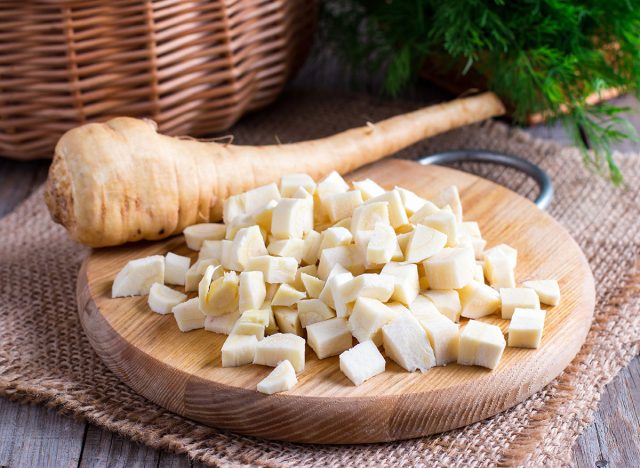
Fiber per 1 cup (cooked, sliced): 5.62 grams (20% DV)
They may be unfamiliar to you now, but this root vegetable is worth getting to know. Parsnips are closely related to the carrot family and one cup (sliced) of this mildly sweet veggie contains a steady 7 grams of fiber. Try roasting parsnips as you would potatoes, or dice them up and toss them into a veggie stew to help kill off hunger pangs.
"Good" Sources of Fiber
The following high-fiber foods are "good" sources of fiber, meaning they contain more than 10% but less than 20% of your daily recommended fiber intake.
Pears
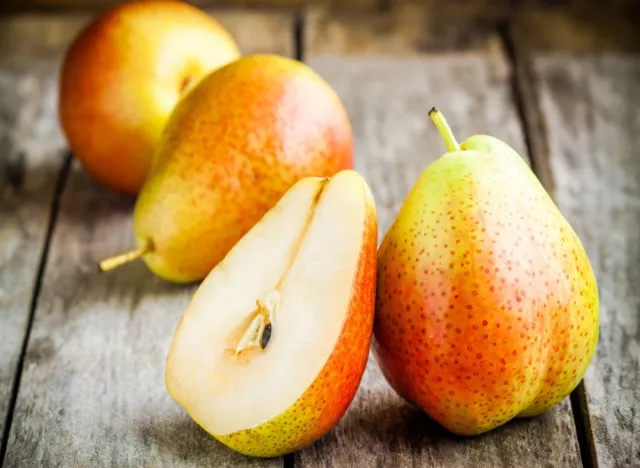
Fiber per medium fruit (with skin): 5.52 grams (19.7%)
One medium pear contains around 5.5 grams of fiber, but to get all those grams, you need to keep the skin intact because that's where most of the nutrient is concentrated. If you ate a large pear, you'd be consuming 7.13 grams of fiber—that's 25% DV! This same rule applies to apples, potatoes, and even that white stuff you love to pick off of oranges after you've peeled the outer layer off!
Bran Flakes
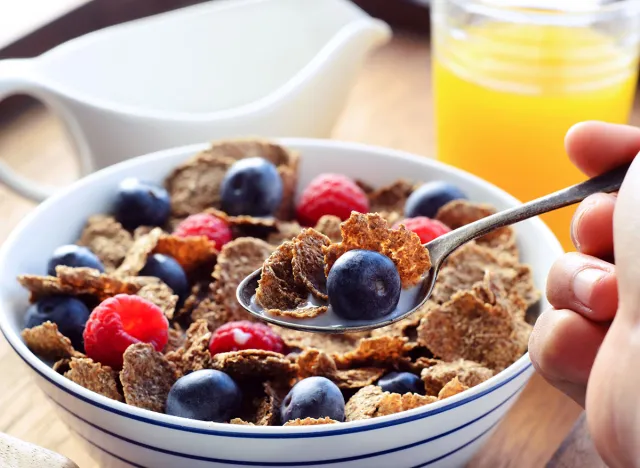
Fiber per ¾ cup: 5.49 grams (19.6% DV)
If you're not a warm porridge person in the morning, fear not. A 1-cup bowl of bran flakes can provide you with nearly 6 grams of fiber. Skip the raisin bran and add in your fruit to keep sugar counts under control and fiber totals even higher.
Sabat suggests eating bran flakes because "they're a good choice for a high-fiber breakfast option and can help promote digestive regularity."
Refried Beans
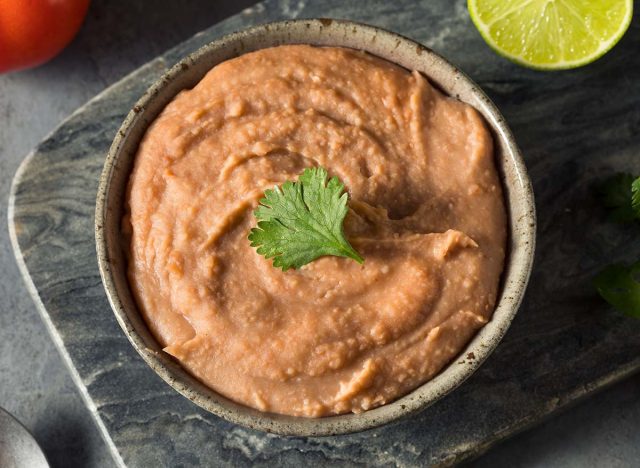
Fiber per ½ cup (canned, fat-free): 5.45 grams (19% DV)
Who knew you could get a good source of fiber from one of your favorite taco sides? Don't pass on this high-fiber food on your next trip to your local Mexican restaurant.
Broccoli
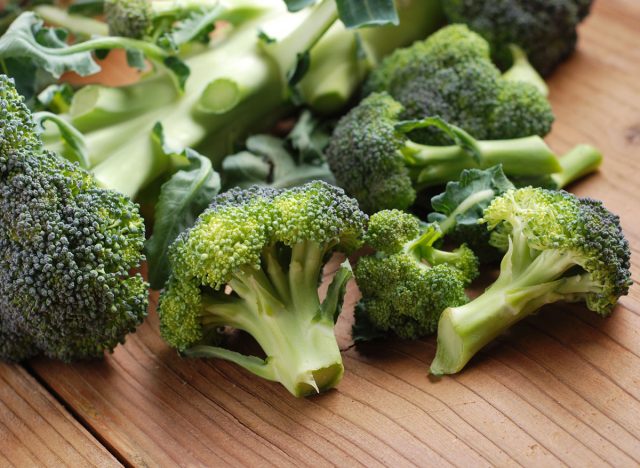
Fiber per 1 cup (cooked, chopped): 5.14 grams (18% DV)
Broccoli is one of the best vegetables to add to your next dinner or lunch for some fiber. It has some of the highest fiber content of most vegetables at over 5 grams per cup. This cruciferous vegetable is more than just a high-fiber source, though. Sabat says that along with fiber, "It is also a good source of vitamins C and K, as well as folate."
Artichoke Hearts
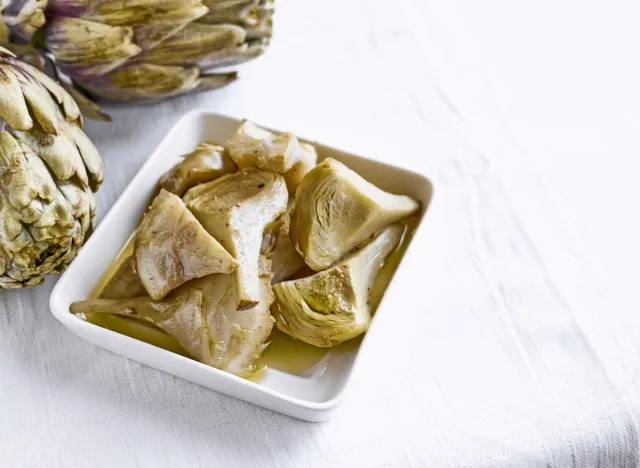
Fiber per ½ cup (cooked): 4.79 grams (17% DV)
Unfortunately, spinach artichoke dip will never make it onto any diet-friendly list—but some of its main ingredients certainly do. These juicy, tender artichoke hearts are just teeming with fiber. "I believe the weight loss benefits associated with greater fiber intake are tied to feelings of fullness and satiety," says Crandall.
Oranges
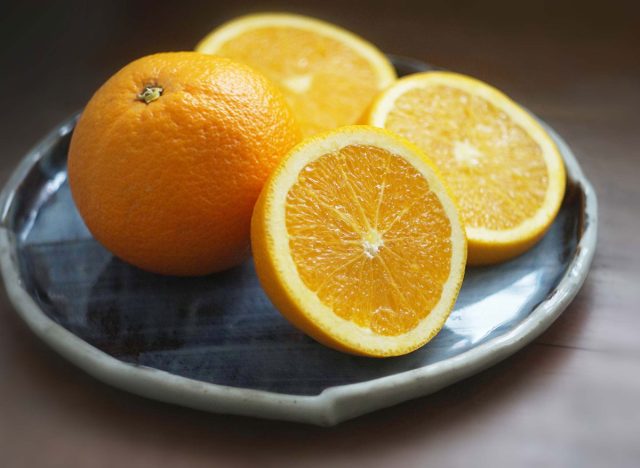
Fiber per large orange (peeled): 4.42 grams (16% DV)
If you can resist picking off every last bit of that pesky white stuff on the orange segments, you'll retain more of the waist-whittling nutrient.
Apple
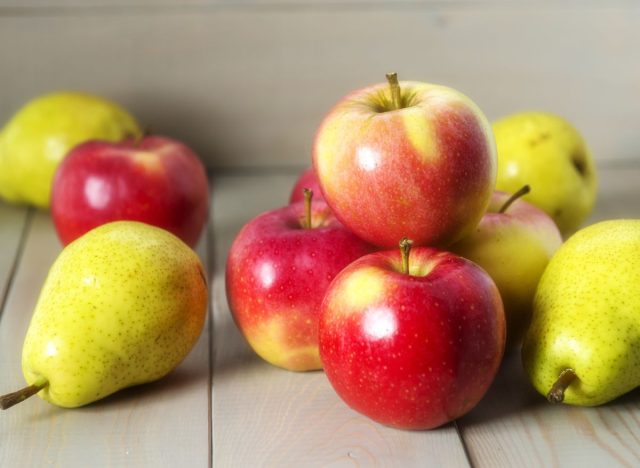
Fiber per medium apple (with skin): 4.37 grams (16% DV)
Apples may trail behind pears in this category, but they're still a good way to sneak more fiber into your day—as long as you don't peel them! One medium apple contains around 4.4 grams of this belly-friendly nutrient and can help ward off junk food cravings between meals.
Figs
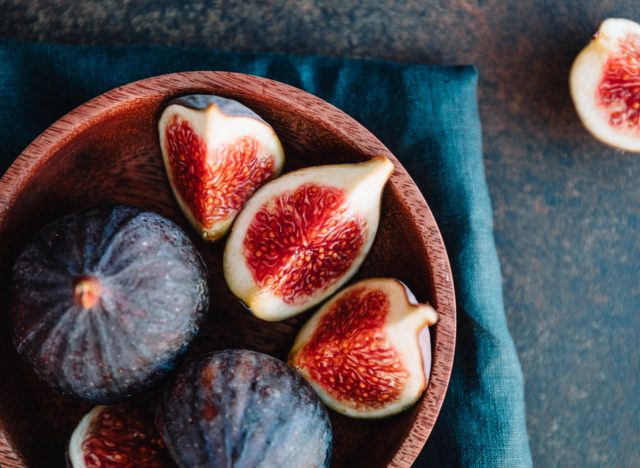
Fiber per 3 medium figs (raw): 4.35 grams (16% DV)
Figs are in season in late June and then again in August through October, so get your hands on these tree fruits during those times to increase your fiber intake!
Snow peas
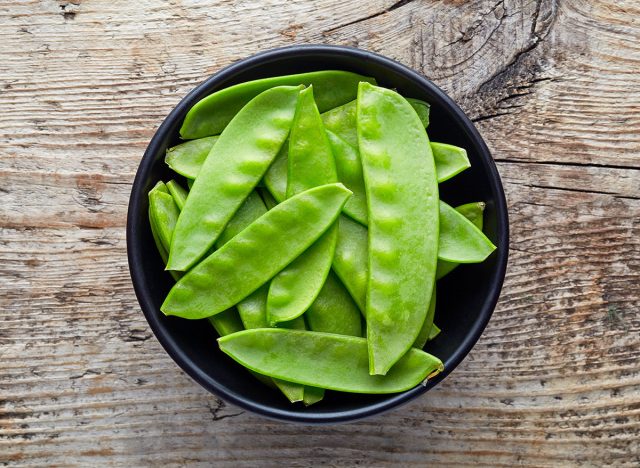
Fiber per 1 cup (cooked): 4.32 grams (15% DV)
Rather than grabbing a bag of chips or pretzels, spend a few minutes at night throwing together a small bag of portable and affordable veggies. Cherry tomatoes, carrots, and mini bell peppers are all great snack options but these satisfying snap peas contain 4 grams of fiber per one-cup serving.
Steel-Cut Oats
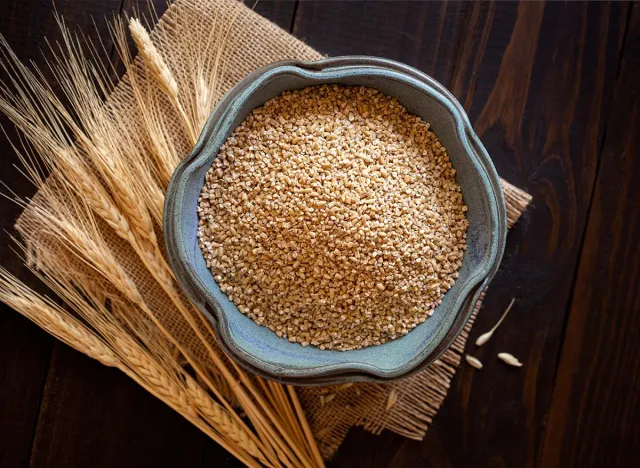
Fiber per ¼ cup (dry): 4.1 grams (15% DV)
Steel-cut oats contain almost double the amount of fiber than rolled oats, which is why you should be opting for these instead. Try one of these overnight oats recipes to give yourself a morning fiber boost with these tasty breakfast treats.
According to Young, "Oats are rich in a specific type of fiber called soluble fiber, which helps to lower cholesterol levels and improve heart health, as well as help to stabilize blood sugar levels."
Bulgur
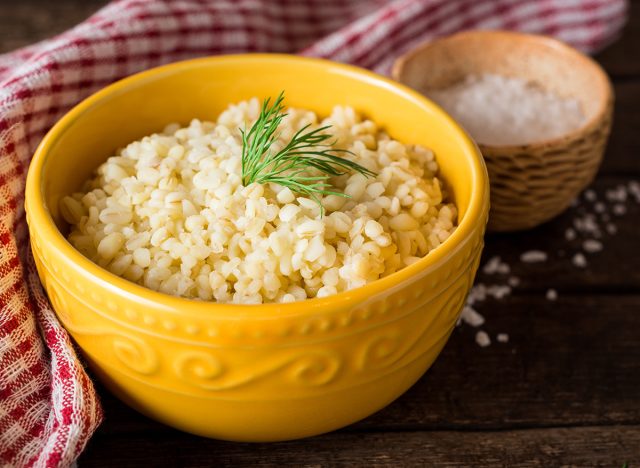
Fiber per ½ cup (cooked): 4.1 grams (15% DV)
Bulgur is another high-fiber wheat you should be adding to your diet. For a delicious side salad, combine bulgur with cucumbers, chickpeas, red onion, and dill, and dress with a lemon vinaigrette.
Rolled Oats
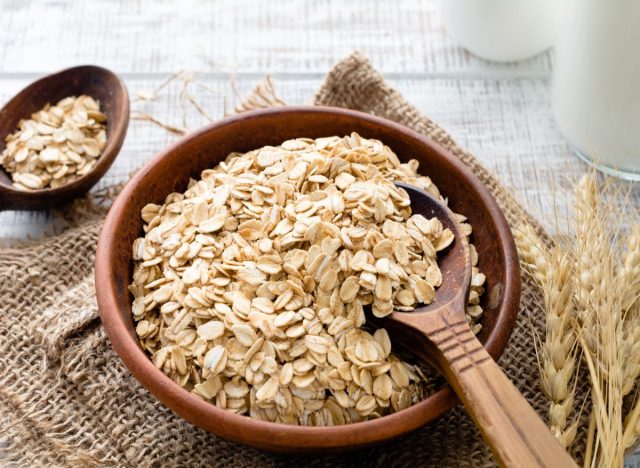
Fiber per 1/2 cup (dry): 4.1 grams (15% DV)
With 4 grams of fiber per serving, starting your day with a hearty bowl of oatmeal is sure to set you on the right track. A study published in the Nutrition Journal found that participants who consumed oatmeal regularly experienced a drop in bad cholesterol (and waist size!) due to their increased fiber intake.
Cocoa Powder
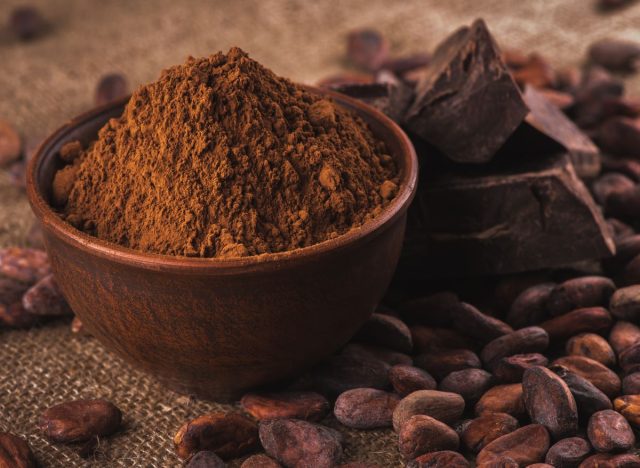
Fiber per 2 Tbsp (unsweetened): 4 grams (14% DV)
You don't have to cut chocolate out entirely to have a healthy diet. If you're craving chocolate, some cocoa powder in a protein shake could kick your cravings without adding excess calories.
Edamame
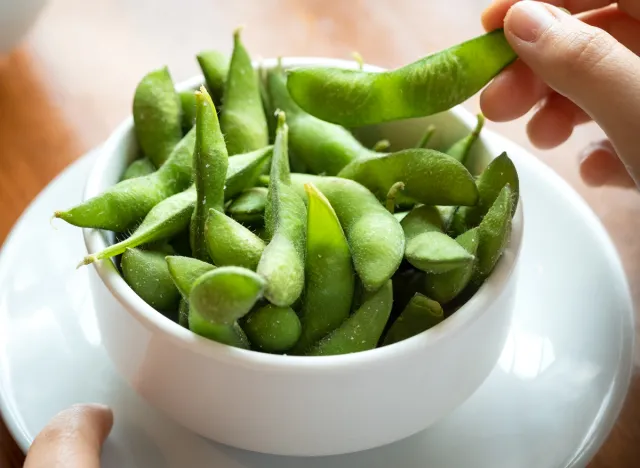
Fiber per ½ cup (beans only): 4 grams (14% DV)
Edamame is one of the many beans that are packed with fiber. Just half a cup of edamame has four grams of fiber. Munch on these on your next snack break to get a dose of fiber in your day. We like tossing them with some sesame oil and hot sauce.
Russet Potato
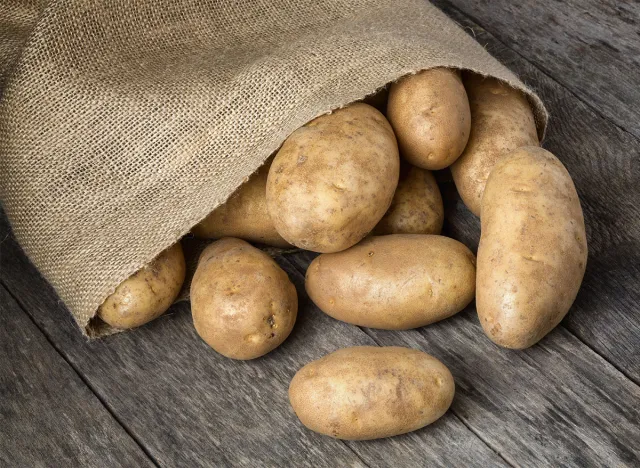
Fiber per 1 medium Russet potato (baked, with skin): 3.98 grams (14% DV)
Potatoes have gotten a bad reputation, but they're a great source of fiber. Just one large russet potato has nearly 7 grams of fiber, and you can easily add them to just about any dish you make. Just don't forget to eat the skin!
Whole Grain Pasta
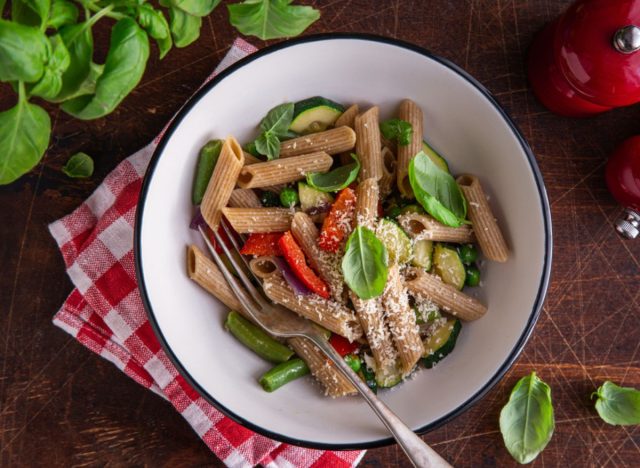
Fiber per 1 cup (cooked): 3.78 grams, penne (14% DV); 4.56 grams, spaghetti (16% DV)
Not all pasta is created equal; some are pretty good for you! "I have people look at their brands and read their labels to determine what is considered a good source of fiber because it is going to vary from brand to brand," says Crandall. On average, whole wheat pasta contains 6.3 grams of fiber per one-cup cooked serving.
Sweet Potato
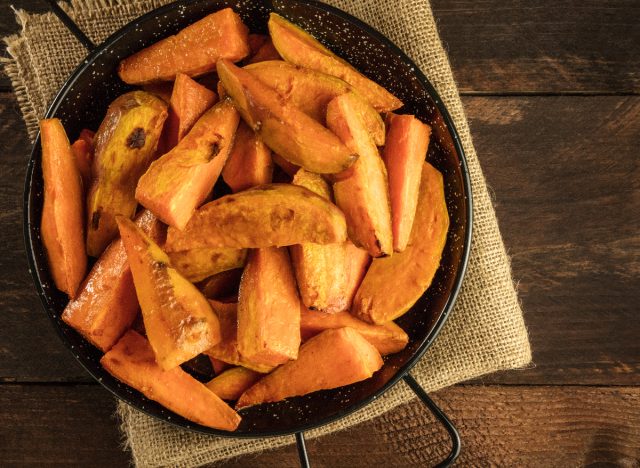
Fiber per 1 medium sweet potato (baked, with skin): 3.76 grams (13% DV)
"Fiber has no magical fat-burning properties; simply put, it helps you feel full without adding a lot of extra calories to your diet," explains Crandall. "When you have a baked potato (with skin) instead of a bag of potato chips, for example, you're not only eating fewer calories, but you're less likely to feel hungry again an hour later." Sweet potatoes, in particular, boast around 6 grams of fiber per large baked potato for only 160 calories.
Dried Figs
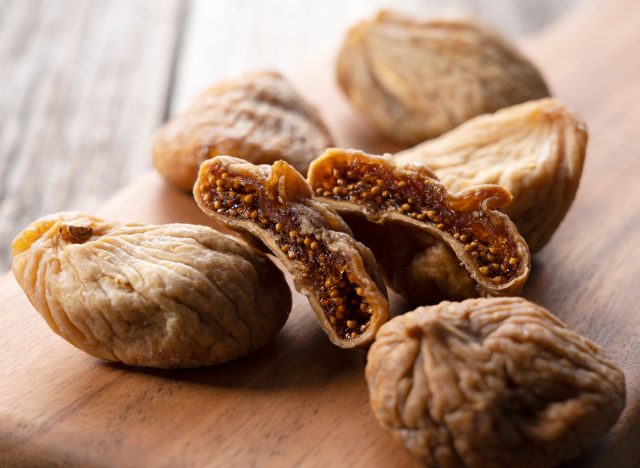
Fiber per ¼ cup (dried): 3.65 grams (13% DV)
Dried figs are a very portable and very palatable source. One little, dried fig contains nearly one gram of fiber and about 20 calories. Mix a few in a bag with some nuts, and you've got yourself a healthy and wholesome snack for when you're on the go and starting to run out of fuel.
Carrots
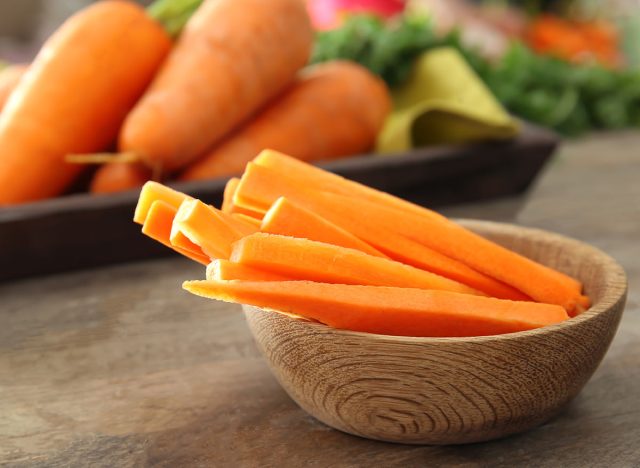
Fiber per 1 cup (raw): 3.58 grams (13% DV)
Believe it or not, this Bugs Bunny favorite can increase feelings of fullness post-snacking—much more than any pretzel sticks can. Throw a bunch in a small baggie and pull them out mid-afternoon when the munchies kick in.
Canned Pumpkin
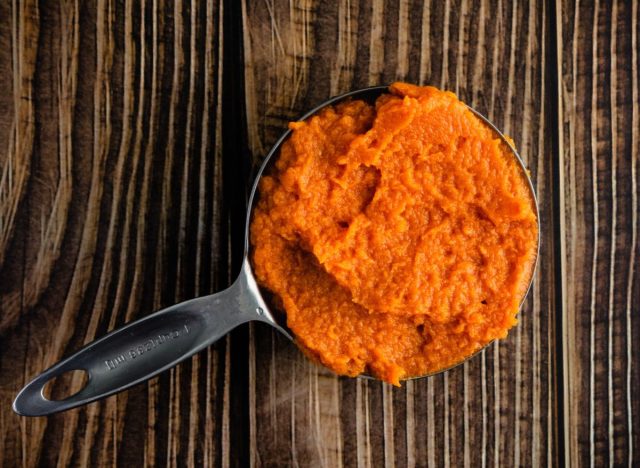
Fiber per ½ cup: 3.55 grams (13% DV)
You should be eating this fall-favorite vegetable year-round for its high fiber content. Despite being pureed, each half-cup serving of delicious pumpkin has almost 4 grams of fiber.
Almonds
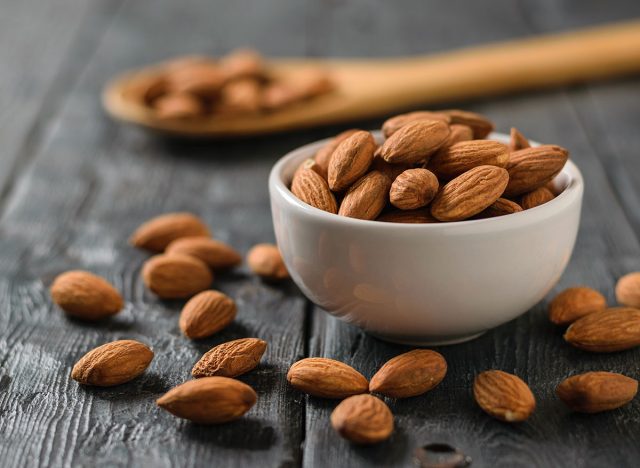
Fiber per 1 ounce, raw (23 almonds): 3.54 grams (13% DV)
Nuts and seeds are always great while you're on the go. Snack on roasted almonds, which have nearly 4 grams of fiber per quarter-cup serving and 7 grams of protein. If you want even more fiber, pick up almonds labeled as raw, natural, or unroasted to get more fiber bang for your buck.
"Almonds are also rich in healthy fats and essential nutrients, making them a nutritious snack option that can help with weight management," adds Sabat.
Teff
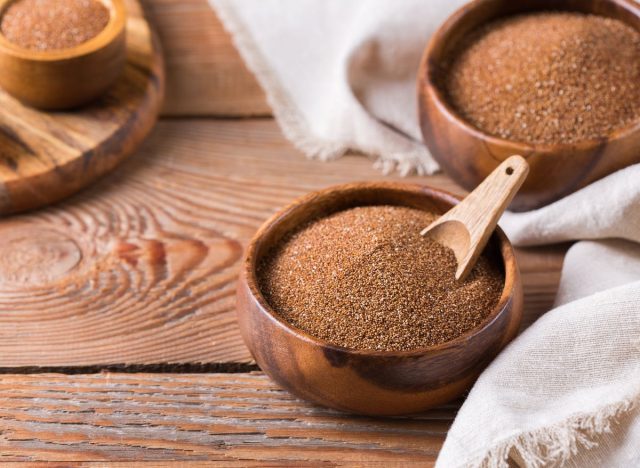
Fiber per ½ cup (cooked): 3.53 grams (13% DV)
Teff is a super grain known for its high fiber content. Add this to your dinner plate instead of refined grains to get a hearty and fiber-packed kick into your meal.
Popcorn
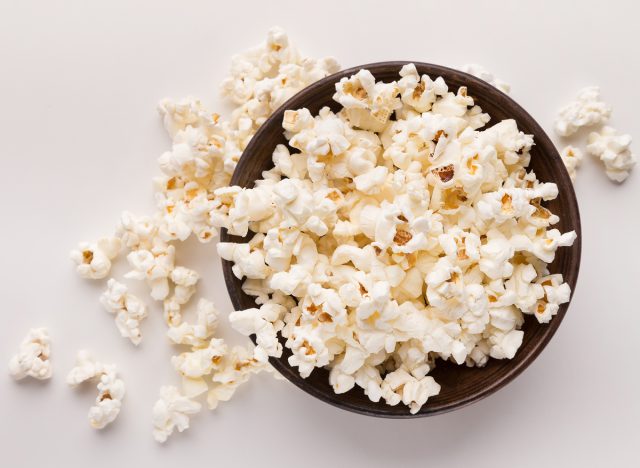
Fiber per 3 cups (air-popped): 3.48 grams (12% DV)
When you think of whole grains, chances are this movie theater favorite doesn't come to mind—although it should. Since popcorn is considered a whole grain, it is relatively decent in fiber. Just be sure to stick to air-popped to avoid unwanted calories or artificial flavors.
Avocado
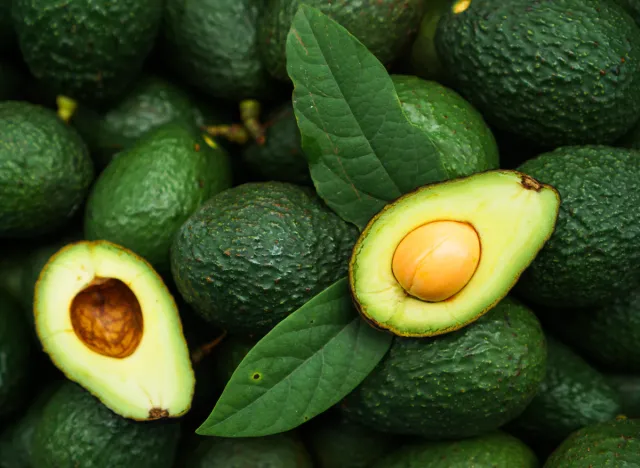
Fiber per ¼ avocado: 3.4 grams (12% DV)
It's not the spinach leaves that are going to fill you up, but rather that creamy avocado you slice on top of them. On average, one medium avocado contains around 10-13 grams of filling fiber, and adding it to your meals or finding a few awesome avocado recipes can increase satiety tremendously.
Banana
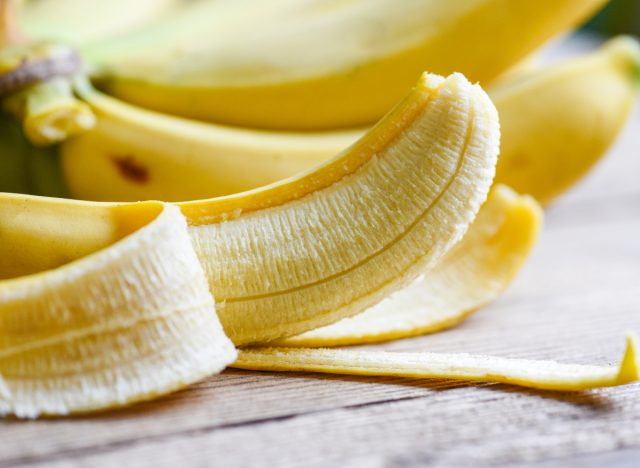
Fiber per medium banana (peeled): 3.07 grams (11% DV)
If you're craving something fruity, bananas are one of the best fiber-rich fruits to have. One banana has a little over 3 grams of fiber and also contains a high amount of potassium, an essential nutrient that helps regulate blood pressure. And there are more health benefits of bananas beyond their high-fiber power.
Pearled Barley
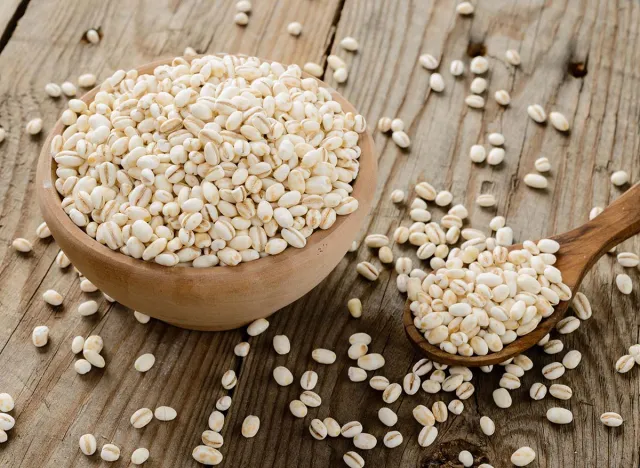
Fiber per ½ cup (cooked): 3 grams (11% DV)
Incorporate this healthy grain into soups and stews, or even feature it as a side dish with some added spices. The dietary fiber found in this grain "helps you extract and remove cholesterol, which is correlated with heart disease," explains Crandall.
Whole Grain Bread
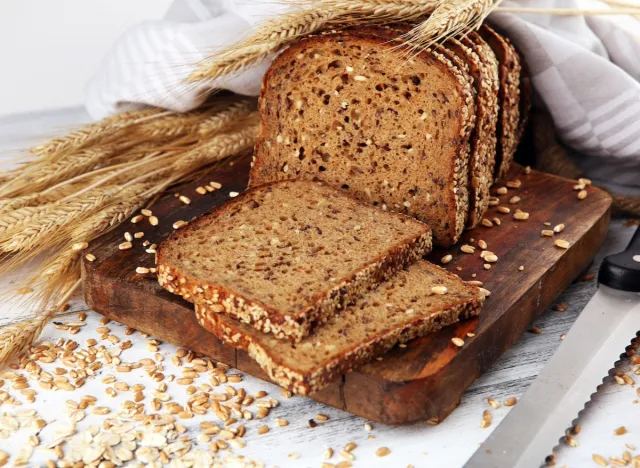
Fiber per slice: 3 grams (11% DV)
One slice of true whole-grain bread can contain around 4 or 5 grams of fiber and upwards of 16 grams of inflammation-reducing whole grains. Recently, though, brands are doubling up on fiber content and boasting over 10 grams per slice in some cases."When you're looking at your bread, look for that first ingredient that says whole grain," Crandall recommends. "You want to stick with whole grain, not multigrain, which simply means that there are different types of grains present."
Pistachios
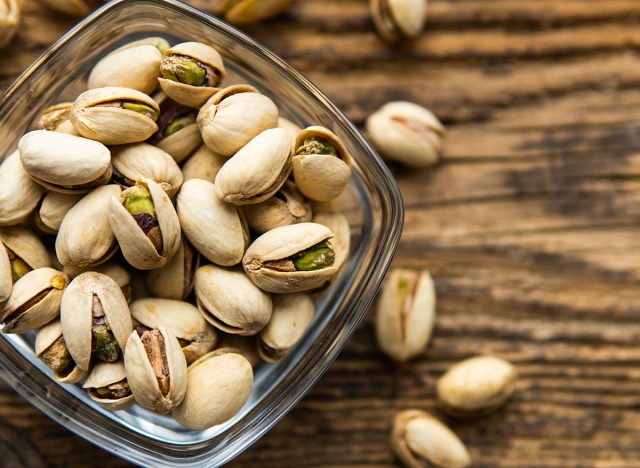
Fiber per 1 ounce, raw (49 kernels): 3 grams (11% DV)
These tiny nuts are filled with fiber, which helps keep your digestive system running smoothly. A one-ounce serving of pistachios will give you 3 grams of fiber and 6 grams of protein.
This article has been updated to include additional entries, fact-checking, expert quotes, and reformatted for better readability.
- Source: Dietary fiber: Essential for a healthy diet. (2022c, November 4). Mayo Clinic. https://www.mayoclinic.org/healthy-lifestyle/nutrition-and-healthy-eating/in-depth/fiber/art-20043983#:~:text=Soluble%20fiber%20found%20in%20beans,%22bad%2C%22%20cholesterol%20levels.
- Source: Kelly, R. K., Calhoun, J., Hanus, A., Payne-Foster, P., Stout, R., & Sherman, B. W. (2023). Increased dietary fiber is associated with weight loss among Full Plate Living program participants. Frontiers in nutrition, 10, 1110748. https://doi.org/10.3389/fnut.2023.1110748
- Source: https://www.fda.gov/downloads/Food/GuidanceRegulation/GuidanceDocumentsRegulatoryInformation/LabelingNutrition/UCM513814.pdf
- Source: https://www.ars.usda.gov/ARSUserFiles/80400530/pdf/DBrief/12_fiber_intake_0910.pdf
- Source: FoodData Central. (n.d.-ay). https://fdc.nal.usda.gov/fdc-app.html#/food-details/173746/nutrients
- Source: FoodData Central. (n.d.-az). https://fdc.nal.usda.gov/fdc-app.html#/food-details/173746/nutrients
- Source: FoodData Central. (n.d.-ba). https://fdc.nal.usda.gov/fdc-app.html#/food-details/169294/nutrients
- Source: FoodData Central. (n.d.-bb). https://fdc.nal.usda.gov/fdc-app.html#/food-details/175188/nutrients
- Source: FoodData Central. (n.d.-bc). https://fdc.nal.usda.gov/fdc-app.html#/food-details/172429/nutrients
- Source: https://fdc.nal.usda.gov/fdc-app.html#/food-details/167755/nutrients
- Source: FoodData Central. (n.d.-be). https://fdc.nal.usda.gov/fdc-app.html#/food-details/175254/nutrients
- Source: FoodData Central. (n.d.-bf). https://fdc.nal.usda.gov/fdc-app.html#/food-details/168523/nutrients
- Source: FoodData Central. (n.d.-bg). https://fdc.nal.usda.gov/fdc-app.html#/food-details/173946/nutrients
- Source: FoodData Central. (n.d.-bh). https://fdc.nal.usda.gov/fdc-app.html#/food-details/170102/nutrients
- Source: FoodData Central. (n.d.-bi). https://fdc.nal.usda.gov/fdc-app.html#/food-details/169296/nutrients
- Source: Brown, L. D., Rosner, B., Willett, W., & Sacks, F. M. (1999). Cholesterol-lowering effects of dietary fiber: a meta-analysis. The American Journal of Clinical Nutrition, 69(1), 30–42. https://doi.org/10.1093/ajcn/69.1.30
- Source: FoodData Central. (n.d.-bj). https://fdc.nal.usda.gov/fdc-app.html#/food-details/175194/nutrients
- Source: FoodData Central. (n.d.-bk). https://fdc.nal.usda.gov/fdc-app.html#/food-details/173799/nutrients
- Source: FoodData Central. (n.d.-bl). https://fdc.nal.usda.gov/fdc-app.html#/food-details/1100612/nutrients
- Source: FoodData Central. (n.d.-bm). https://fdc.nal.usda.gov/fdc-app.html#/food-details/169134/nutrients
- Source: FoodData Central. (n.d.-bn). https://fdc.nal.usda.gov/fdc-app.html#/food-details/169414/nutrients
- Source: FoodData Central. (n.d.-bo). https://fdc.nal.usda.gov/fdc-app.html#/food-details/170009/nutrients
- Source: FoodData Central. (n.d.-bp). https://fdc.nal.usda.gov/fdc-app.html#/food-details/169118/nutrients
- Source: FoodData Central. (n.d.-bq). https://fdc.nal.usda.gov/fdc-app.html#/food-details/173888/nutrients
- Source: FoodData Central. (n.d.-br). https://fdc.nal.usda.gov/fdc-app.html#/food-details/172465/nutrients
- Source: FoodData Central. (n.d.-bs). https://fdc.nal.usda.gov/fdc-app.html#/food-details/169967/nutrients
- Source: FoodData Central. (n.d.-bt). https://fdc.nal.usda.gov/fdc-app.html#/food-details/169311/nutrients
- Source: FoodData Central. (n.d.-bu). https://fdc.nal.usda.gov/fdc-app.html#/food-details/169097/nutrients
- Source: FoodData Central. (n.d.-bv). https://fdc.nal.usda.gov/fdc-app.html#/food-details/171688/nutrients
- Source: FoodData Central. (n.d.-bw). https://fdc.nal.usda.gov/fdc-app.html#/food-details/173021/nutrients
- Source: FoodData Central. (n.d.-bx). https://fdc.nal.usda.gov/fdc-app.html#/food-details/2345507/nutrients
- Source: FoodData Central. (n.d.-by). https://fdc.nal.usda.gov/fdc-app.html#/food-details/169705/nutrients
- Source: FoodData Central. (n.d.-bz). https://fdc.nal.usda.gov/fdc-app.html#/food-details/170287/nutrients
- Source: FoodData Central. (n.d.-ca). https://fdc.nal.usda.gov/fdc-app.html#/food-details/173904/nutrients
- Source: Rasane P, Jha A, Sabikhi L, Kumar A, Unnikrishnan VS. Nutritional advantages of oats and opportunities for its processing as value added foods - a review. J Food Sci Technol. 2015 Feb;52(2):662-75. doi: 10.1007/s13197-013-1072-1. Epub 2013 Jun 25. PMID: 25694675; PMCID: PMC4325078.
- Source: FoodData Central. (n.d.-cb). https://fdc.nal.usda.gov/fdc-app.html#/food-details/169593/nutrients
- Source: FoodData Central. (n.d.-cc). https://fdc.nal.usda.gov/fdc-app.html#/food-details/168411/nutrients
- Source: FoodData Central. (n.d.-cd). https://fdc.nal.usda.gov/fdc-app.html#/food-details/170030/nutrients
- Source: FoodData Central. (n.d.-cf). https://fdc.nal.usda.gov/fdc-app.html#/food-details/168910/nutrients
- Source: FoodData Central. (n.d.-ce). https://fdc.nal.usda.gov/fdc-app.html#/food-details/168910/nutrients
- Source: FoodData Central. (n.d.-cg). https://fdc.nal.usda.gov/fdc-app.html#/food-details/170134/nutrients
- Source: FoodData Central. (n.d.-ch). https://fdc.nal.usda.gov/fdc-app.html#/food-details/174665/nutrients
- Source: FoodData Central. (n.d.-ci). https://fdc.nal.usda.gov/fdc-app.html#/food-details/170393/nutrients
- Source: FoodData Central. (n.d.-cj). https://fdc.nal.usda.gov/fdc-app.html#/food-details/168450/nutrients
- Source: FoodData Central. (n.d.-ck). https://fdc.nal.usda.gov/fdc-app.html#/food-details/170567/nutrients
- Source: FoodData Central. (n.d.-cl). https://fdc.nal.usda.gov/fdc-app.html#/food-details/168918/nutrients
- Source: FoodData Central. (n.d.-cm). https://fdc.nal.usda.gov/fdc-app.html#/food-details/167959/nutrients
- Source: FoodData Central. (n.d.-cn). https://fdc.nal.usda.gov/fdc-app.html#/food-details/171705/nutrients
- Source: https://fdc.nal.usda.gov/fdc-app.html#/food-details/170285/nutrients
- Source: FoodData Central. (n.d.-cq). https://fdc.nal.usda.gov/fdc-app.html#/food-details/168013/nutrients
- Source: Vitaglione, P., Mennella, I., Ferracane, R., Rivellese, A. A., Giacco, R., Ercolini, D., Gibbons, S. M., La Storia, A., Gilbert, J. A., Jonnalagadda, S. S., Thielecke, F., Gallo, M., Scalfi, L., & Fogliano, V. (2015). Whole-grain wheat consumption reduces inflammation in a randomized controlled trial on overweight and obese subjects with unhealthy dietary and lifestyle behaviors: role of polyphenols bound to cereal dietary fiber. The American Journal of Clinical Nutrition, 101(2), 251–261. https://doi.org/10.3945/ajcn.114.088120
- Source: FoodData Central. (n.d.-cr). https://fdc.nal.usda.gov/fdc-app.html#/food-details/170184/nutrients









